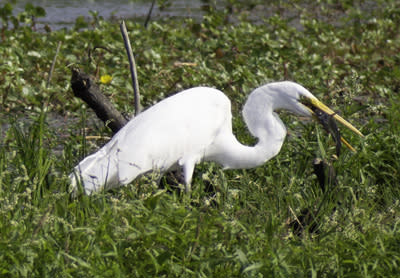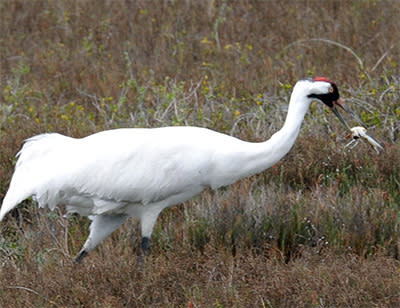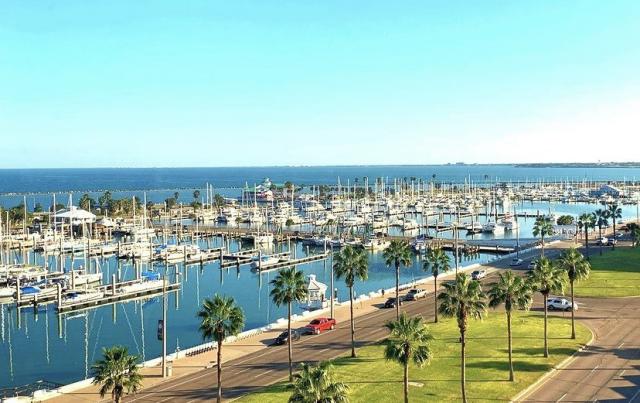Corpus Christi, and the Coastal Bend form one of the richest birding areas in the country. For ten years running, Corpus Christi won the title of America’s Birdiest City—not a marketing campaign but an honor achieved during an annual 72-hour bird count by Audubon birdwatchers all across the country. There are several reasons for this diversity of bird life. Located in the middle of the continent, the Coastal Bend gets birds from both the eastern and western halves of North America, particularly in spring and fall migration. In addition, there are numerous south Texas specialties, birds primarily of Mexico and the tropics whose range extends north into the Coastal Bend. Also, Corpus Christi and the Coastal Bend offer a wide variety of habitats, from gulf beaches to salt marshes and bays, from woodlands to mesquite chaparral and grasslands. The numerous habitats provide a home for a wide variety of birds. Many of the habitats, such as salt marshes and estuaries, support large numbers of birds because of the rich supply of food. The result is that there are many species of birds in Corpus Christi and the Coastal Bend, not only in migration, but all year round.
Corpus Christi and the Coastal Bend not only have a wide variety of birds, but a wide variety of birding experiences. The Coastal Bend is indeed one of the great birding areas of the country; there is something for every birder, no matter what the level of expertise or time of year.
Spring
 The high point of the birding year in the Coastal Bend is spring migration, which begins in March with the arrival of the shorebirds, including American Golden Plover and Upland Sandpiper. Tule Lake, the Naval Air Station (NAS) Causeway, and Hans Suter Wildlife Refuge in Corpus Christi, Indian Point and Sunset Lake in Portland, and the two boardwalks at Charlie’s Pasture in Port Aransas are good locations for numerous species of sandpipers and plovers. A few of the migrant songbirds arrive in March, but the tide begins to swell in April and reaches its peak at the end of that month, which coincides with the annual Birdiest Festival in America hosted by South Texas Botanical Gardens & Nature Center. Songbirds are still plentiful through the first half of May. If you are looking for warblers, orioles, tanagers, grosbeaks, and buntings, add these sites to your list: Blucher Park, Rose Hill Cemetery, the Packery Channel Oak Motte Sanctuary, and Polliwog Ponds in Corpus Christi; Paradise Pond in Port Aransas; Live Oak Park in Ingleside; Goose Island State Park north of Rockport.
The high point of the birding year in the Coastal Bend is spring migration, which begins in March with the arrival of the shorebirds, including American Golden Plover and Upland Sandpiper. Tule Lake, the Naval Air Station (NAS) Causeway, and Hans Suter Wildlife Refuge in Corpus Christi, Indian Point and Sunset Lake in Portland, and the two boardwalks at Charlie’s Pasture in Port Aransas are good locations for numerous species of sandpipers and plovers. A few of the migrant songbirds arrive in March, but the tide begins to swell in April and reaches its peak at the end of that month, which coincides with the annual Birdiest Festival in America hosted by South Texas Botanical Gardens & Nature Center. Songbirds are still plentiful through the first half of May. If you are looking for warblers, orioles, tanagers, grosbeaks, and buntings, add these sites to your list: Blucher Park, Rose Hill Cemetery, the Packery Channel Oak Motte Sanctuary, and Polliwog Ponds in Corpus Christi; Paradise Pond in Port Aransas; Live Oak Park in Ingleside; Goose Island State Park north of Rockport.
Summer
 After the passage of the migrants, the birding pace slackens a bit but still remains brisk. The focus now shifts to the south Texas specialty birds such as Groove-billed Ani, Green Jay, and Audubon’s Oriole. Hazel Bazemore Country Park in Corpus Christi, Corpus Christi State Park, and Choke Canyon State Park offer opportunities for these and numerous others. Some birds arrive only with the summer, and these include water birds like Wood Stork and Magnificent Frigatebird. The ship channel in Port Aransas is the place for frigatebirds, while Tule Lake and Wright’s Pond are good sites for the storks. Many of the herons, egrets, terns, Roseate Spoonbill, White Ibis, and Black Skimmer can be seen in places such as Hans Suter Wildlife Refuge, Indian Point, and the Port Aransas Birding Center.
After the passage of the migrants, the birding pace slackens a bit but still remains brisk. The focus now shifts to the south Texas specialty birds such as Groove-billed Ani, Green Jay, and Audubon’s Oriole. Hazel Bazemore Country Park in Corpus Christi, Corpus Christi State Park, and Choke Canyon State Park offer opportunities for these and numerous others. Some birds arrive only with the summer, and these include water birds like Wood Stork and Magnificent Frigatebird. The ship channel in Port Aransas is the place for frigatebirds, while Tule Lake and Wright’s Pond are good sites for the storks. Many of the herons, egrets, terns, Roseate Spoonbill, White Ibis, and Black Skimmer can be seen in places such as Hans Suter Wildlife Refuge, Indian Point, and the Port Aransas Birding Center.
Fall
 Summer doesn’t last long, at least on the birding calendar; the pace picks up with the fall shorebird migration which begins in late July and is in full swing by mid-August. The same sandpipers which headed north in April are back, some only as transients on their way further south, and some to stay for the winter. The songbird migration begins in late August with flycatchers leading the way, followed by warblers, orioles, and buntings in September and October. The fall migration has fewer birds than spring, but this is compensated for by being stretched out over a longer period. The same locations which were good in spring are the places to look in fall.
Summer doesn’t last long, at least on the birding calendar; the pace picks up with the fall shorebird migration which begins in late July and is in full swing by mid-August. The same sandpipers which headed north in April are back, some only as transients on their way further south, and some to stay for the winter. The songbird migration begins in late August with flycatchers leading the way, followed by warblers, orioles, and buntings in September and October. The fall migration has fewer birds than spring, but this is compensated for by being stretched out over a longer period. The same locations which were good in spring are the places to look in fall.
One of the highlights of fall is the Ruby-throated Hummingbird migration in late August and September, when thousands pass through the Coastal Bend. The HummerBird Celebration in Rockport/Fulton, in mid-September, offers a great opportunity to see and study these little gems.
 Another of the great fall birding experiences is the Hawk Watch at Hazel Bazemore County Park. The Hawk Watch runs from August 15 through November 15 and over a million migrating raptors have been recorded in a single season from the hawk watch platform at the park. The peak of the season is in late September and is marked by a three-day festival, the Celebration of Flight, the last weekend in September. On a good day it is possible to see hundreds (sometimes even thousands) of migrating hawks swirling overhead as they circle to gain altitude in an updraft of rising air.
Another of the great fall birding experiences is the Hawk Watch at Hazel Bazemore County Park. The Hawk Watch runs from August 15 through November 15 and over a million migrating raptors have been recorded in a single season from the hawk watch platform at the park. The peak of the season is in late September and is marked by a three-day festival, the Celebration of Flight, the last weekend in September. On a good day it is possible to see hundreds (sometimes even thousands) of migrating hawks swirling overhead as they circle to gain altitude in an updraft of rising air.
By late October and November, the ducks are beginning to arrive along with many of the sparrows and winter hawks. Peregrines and Merlins can be found on Padre and Mustang Islands and rafts of ducks in the bays and on freshwater ponds such as Polliwog Ponds, the Port Aransas Birding Center, and Choke Canyon State Park. November also marks the arrival of the most famous birds of the Coastal Bend, the Whooping Cranes, back from their nesting grounds in northern Canada. The cranes can be seen frequently from the observation tower at Aransas National Wildlife Refuge (usually at a distance) or from one of the several boats which make the trip from Port Aransas or Rockport/Fulton to the refuge on Whooping Crane tours. The sight of a family of these great birds, striding through the marshes, is an unforgettable experience.
Winter
 Winter birding is excellent in the Coastal Bend. In addition to the Whooping Cranes, their less famous cousins, Sandhill Cranes, are frequently found feeding in pastures and agricultural fields, as are flocks of Snow, Ross’s, and White-fronted Geese. A glance at the checklist will show that many of the species are at peak abundance in winter. The weather is usually pleasant and there is always the possibility that some rare stray from the far north or west will show up. Pollywog Ponds, Hazel Bazemore County Park, Rose Hill Cemetery, and the Sandia/Knolle Farms area are good locations for the wintering songbirds. The highlight of late winter is the Celebration of Whooping Cranes and Other Birds held in Port Aransas on the last weekend in February. The festival has hosts at most of the local sites as well as speakers and birding tours. And then, at the end of February, March, and spring migration are just around the corner.
Winter birding is excellent in the Coastal Bend. In addition to the Whooping Cranes, their less famous cousins, Sandhill Cranes, are frequently found feeding in pastures and agricultural fields, as are flocks of Snow, Ross’s, and White-fronted Geese. A glance at the checklist will show that many of the species are at peak abundance in winter. The weather is usually pleasant and there is always the possibility that some rare stray from the far north or west will show up. Pollywog Ponds, Hazel Bazemore County Park, Rose Hill Cemetery, and the Sandia/Knolle Farms area are good locations for the wintering songbirds. The highlight of late winter is the Celebration of Whooping Cranes and Other Birds held in Port Aransas on the last weekend in February. The festival has hosts at most of the local sites as well as speakers and birding tours. And then, at the end of February, March, and spring migration are just around the corner.











